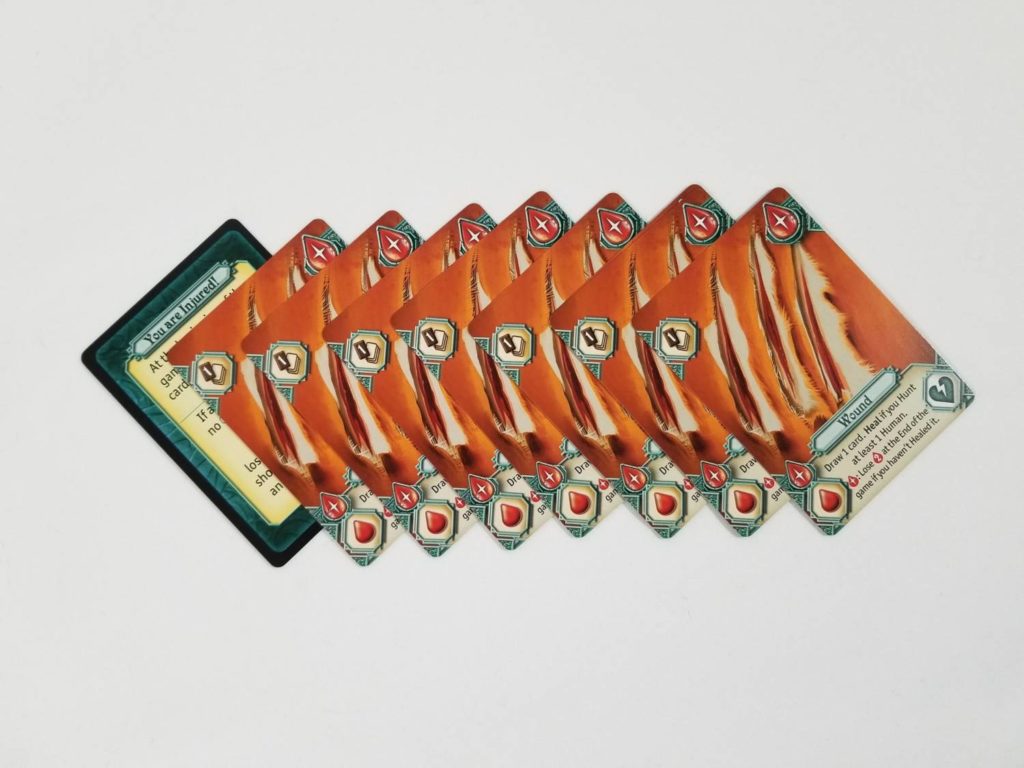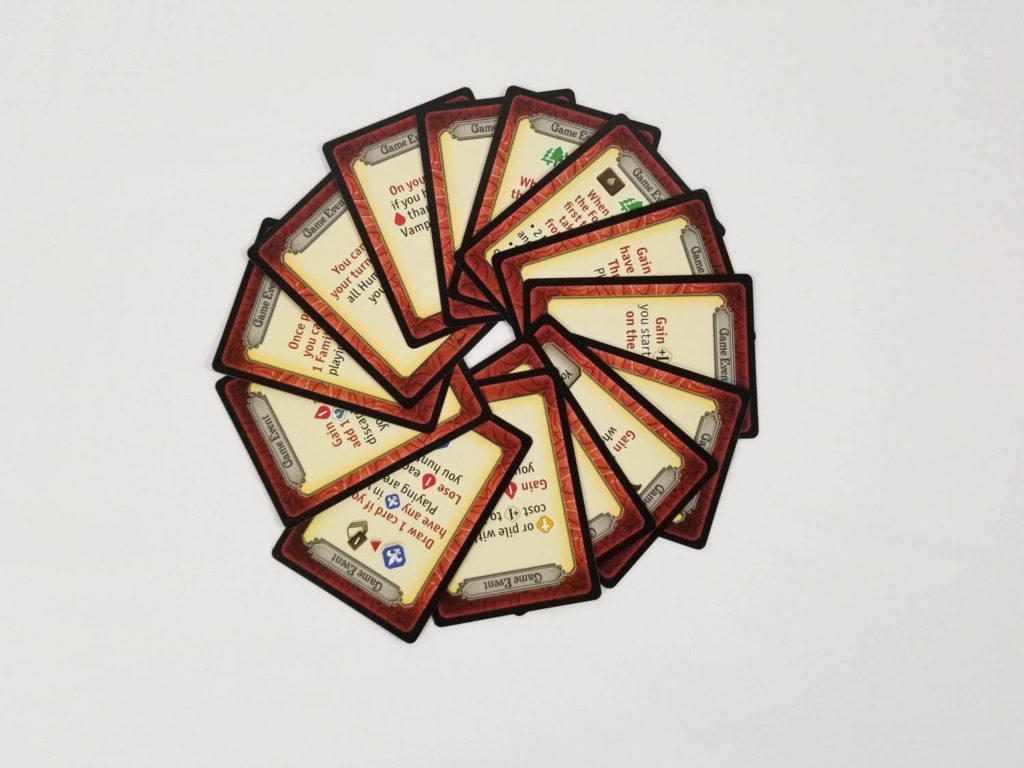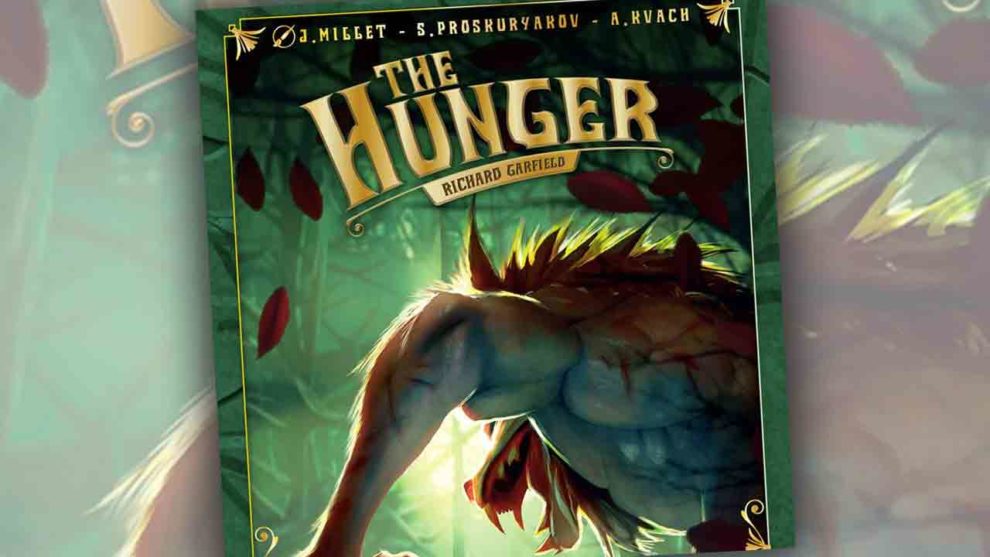Disclosure: Meeple Mountain received a free copy of this product in exchange for an honest, unbiased review. This review is not intended to be an endorsement.
Last year, I sung the praises of the ridiculously fun, don’t get caught out in the sun, game The Hunger. When I saw there was an expansion being released for it, I pounced on it like a hungry Louis de Pointe du Lac would a particularly plump rat.
Here’s my report.
Note: this review assumes you’re familiar with the base game. If you’re not, go check out my review of The Hunger and then come back.
What’s New?
Wounds
First, there is the concept of ‘wounds’. At the start of a game where this expansion is included, each player receives eight ‘Wound’ cards which lie on top of a single “You are injured” card. Certain things which take place in the game may result in a player receiving one or more wounds. Once a player is tasked with drawing a wound but doesn’t have one in their supply, they start losing victory points for each wound they can no longer take. Furthermore, if wounds aren’t healed (removed from their deck) by the end of the game, the player will lose two victory points per wound remaining in their deck during end-of-game scoring. Wounds can be healed by hunting humans during a turn in which one or more wounds were played from the player’s hand.

For the most part, wounds aren’t as harmful as they sound. Using your speed to hunt is very easy to do, so they’re relatively easy to get rid of. And, unlike the junk cards in other games, which only serve to clutter your deck and make your hand less efficient during turns in which they are drawn, each wound played from your hand allows you to draw a card to replace it. That being said, burning through your deck in a card drawing frenzy with this expansion isn’t always preferable. Because sometimes, you might find yourself going up against a Threat.
But, before we talk about Threats, let’s talk about Events.
Events
Events are the second item this expansion brings to the table. There are two flavors of events: Game events (which last the entire game) and Regular events that arrive, one per round, beginning with round two. Game events will present a unique benefit that all players can enjoy over the entire course of the game. Regular events, on the other hand, are typically negative in nature and are how the Threats are spawned.

Threats
At the bottom of most of the Regular event cards is a colored seal. The color of this seal corresponds to a ‘Spawn Location’ card that will have been drawn during setup (one per row on the Hunt track). If the card matching the seal isn’t already in use, then a Threat is revealed. The player with the fewest victory points draws the Threat card and places it, along with the Spawn Location card, to the right of a row of their choosing, as long as that row doesn’t already have a Threat already assigned to it.
Threats come in the form of entities which traditionally give vampires a lot of headaches: vampire hunters and werewolves. Vampire hunters are tough and hardy. Werewolves will eat any humans that wind up in the 1 column of the Hunting track row they have been assigned to. If a player hunts from a row which contains a Threat, then they must take that Threat into their play area. They immediately receive a number of wounds equal to the Threat’s power. Thereafter, whenever the player shuffles their deck to form a new draw pile, each Threat in their play area will inflict further wounds.

Each Threat has a special ability that will grant the person that defeats it a number of victory points. For instance, the humans eaten by a Werewolf are stored beneath the card. Upon defeating the Werewolf, the player will earn victory points based on how many humans were beneath the card. Even better, all of those human cards get added to the player’s Digested area where they will count for end-of-game scoring purposes.
Threats are defeated using Attack Value, the High Stakes expansion’s final offering.
Attack Value
In the High Stakes expansion, each player’s starting card deck has been replaced by an entirely new one. In addition to the speed value and abilities you’d expect from the base game’s starting cards, most of these new cards also include an Attack Value (denoted by an icon that resembles an open mouth with fangs revealed). This Attack Value can be used in several ways: defeating Threats, improving hunts, and even attacking other vampires.

In addition to an Attack Value, each Threat also has a Life Total. Much like a player can spend their total Speed value in any way they wish, a player may devote any or all of their Attack Value toward defeating them. For each wound inflicted on a Threat, the player will place one of the new heart-shaped Damage tokens on it. These tokens remain on the Threat permanently. Once the number of hearts equals the Threat’s Life Total, the Threat is defeated and the player receives the appropriate bonuses for having done so.
The player may also use Attack Value to improve their hunt. So, if a player has two speed and two Attack Value, they may: move two and hunt for two, move one and hunt for three, hunt for four, or move four. And if their movement causes them to land on top of another vampire, they can even use their Attack Value to attack them.
In the base game, landing on top of another vampire would allow you to push that player’s piece into an adjoining space. That functionality hasn’t changed. What has changed is that you now have the option to spend Attack Value to force them to discard cards from their deck (one card per Attack Value spent). Each human they discard in this way will earn you two points. And if you should cause them to have to reshuffle their deck when they have a Threat sitting in front of them, the overall effect is even nastier.
There are also new Mission Tiles, Bonus tokens, as well a Rose card, introduced that capitalize on these new mechanics.
Thoughts
Let’s cut straight to the chase: if you own The Hunger, then you absolutely need the High Stakes expansion in your life. High Stakes is the type of expansion that identifies the things that make the game it’s expanding fun, and then amplifies those aspects. The push-your-luck aspect of the base game is enlivened by the possibility of taking on Threats. The impetus to push your opponents (and get pushed by them) is ramped up by the ability to fight one another. The new Attack value opens a world of possibilities. This is just a really fun and well-designed expansion.
With High Stakes, decisions that used to be easy aren’t so easy anymore. Using your speed, for instance, used to be a question of moving and/or hunting. How far could you move while also saving enough to hunt? Now you’ve got to consider Attack value with that speed. Do you hold some back to attack an opponent and maybe score some easy points? How many cards does that person have in their deck? Do they have a Threat in their playing area? Will forcing them to discard cause them to reshuffle and take wounds? Is it worth it to you to attack them or would that Attack value be better used for movement and hunting like in the base game?
Or consider the position you’re in if you’re the person with the lowest score when a new Threat is introduced. Which row should you add it to? Should you add it to a row where you think someone is likely to go to saddle them with it? Or do you try to place it somewhere it’s not likely to get picked up so that you can pick it up yourself? After all, defeated Threats are worth a decent number of points and you are the person in last place.
All of these little microdecisions (not to mention the extra setup and the actual teach, if you’re playing with people that have never played with the expansion) add up. What used to be a breezy fifteen round excursion takes a bit longer than it did before. And that’s about the only negative thing I can say about High Stakes. So, be forewarned. It’s going to take some extra time, but there are far worse things than having to spend extra time with an excellent game.
The best thing about High Stakes, though? It all fits into the base game box with room to spare. That pretty much guarantees that I will never play The Hunger without it.












Add Comment